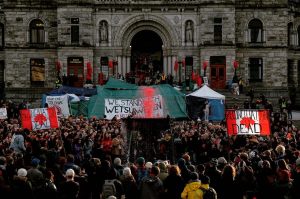Our world is increasingly one of instant gratification: food is delivered to your doorstep, your Uber arrives in minutes, and information is always at your fingertips. One of the most conspicuous displays of this trend is the ever-growing multi-billion dollar fashion industry This current “culture of impatience” has given rise to the new model of “fast-fashion”: a high-street revolution which has seen the development of whole new “seasons” of retail, and never-before-seen acceleration of the industry’s production paradigm. The expanded methods of globalized production have propelled the world of fashion onto the stage of industry giants, with estimated revenue reaching $482.8 billion (in 2012). With an industry of this international scale and influence, we cannot help but assess its impact as a political and economic powerhouse.
Politics today exists within an economy of visibility, which depends upon the transparency and accessibility of media, information, and images. In this culture, visual representation has become a form of political activity, and everyday fashion choices are the most basic form of self-expression. That is not to say that everyone thinks about the political statement they are making every time they put on a shirt in the morning. However, people should be conscious of the socio-economic situation that brought that shirt into their hands. Fashion is an inherently visible industry, contingent upon the display of beauty, wealth, and taste. However, we need to bring to light the systemic ugliness at the backbone of the business.
Our current economic system is one of consumer capitalism. By definition, we are working within a system that presupposes the creation of maximum profits, and thus one that measures success comparative to these profits. The fashion industry is a by-product of such a system: producing short-term goods from exhaustible resources, with the goal of generating as much revenue as possible for its stakeholders. In essence, capitalism seeks infinite growth, without limits on production and profit. Unfortunately, this system is working within a body of limits: the natural world.
Here lies the dichotomy of the fashion industry: we live on a planet with finite resources which lies at odds with capitalism’s ideal of infinite progress.
We are already witnessing first-hand the effects of testing these limits in the devastation of the natural world: the accumulation of textile waste, water pollution from chemical dyes, polyester microfibers contaminating sea life. A documentary by director Andrew Morgan, The True Cost, revealed the use of harmful toxic chemicals in cotton growing, specifically addressing the health risks that these cotton farmers face. Cotton, one of the most highly-used fibers in clothing production, also requires massive amounts of water, yet is largely cultivated in warm, dry areas such as India, placing even greater pressure on an already precious natural resource. If we want to ensure the continued availability of these resources, we are left with no choice but to re-evaluate the current system; something’s got to give.
Either manufacturers have to lower their production margins to environmentally-sustainable levels of output, and risk diminishing profits, or they have to shift the burden elsewhere. Unfortunately, the latter option has become the norm for the two biggest apparel exporters, China, and Bangladesh, where low minimum wages and a lack of trade unions facilitate the exploitation of factory workers in this sector. The pressing burdens of production have not been alleviated, but merely resituated further down the supply chain, where workers’ livelihood, health, and safety are risked in order to meet demand. These conditions can lead to disasters such as Rana Plaza in Bangladesh, in which over 1000 people died in the 2013 factory collapse. Such tragedies are no longer rarities, rather symptoms of a system that turns a blind eye to dangerously unethical conditions, purely because addressing these situations might slow production and decrease profit margins.
Herein lies the ethical dilemma: how can producers reconcile the success of enormous profits, with the failure to secure basic human rights?
We, as consumers, must also take responsibility for these conditions. Our sheer amount of consumption places huge pressures on producer output and the labour force that it would be naïve to assume it is possible to manufacture these volumes of clothing without significant impacts on social and environmental resources. According to the WWF 2017 report on “Changing Fashion,” global clothing consumption doubled between 2000 and 2014. In this current culture of conspicuous consumption, our humane values are replaced by material values; we have become numb to the sacrifice of the health and safety of others, purely because we cannot directly see the blood, sweat, and tears on the clothes we rush to buy. What differentiates the fashion industry from other monopolies, and perhaps what makes it all the more dangerous, is the façade of creative beauty. We seem to have become blinded by beautiful colours and seasonal sales that we no longer consider what lies behind that beauty: a supply chain contingent upon the exploitation of labour and natural resources. The extensive production makes it easy for us to distance ourselves from the problem under the veil of cheap prices.
Sustainable ethical fashion bears higher production costs: skilled workers are used, decent wages are required, and retailers purchase fabric in smaller quantities to reduce waste. Despite these challenges, brands such as Reformation have shown that sustainability and profitability can co-exist. Founded in 2009, the brand known for its direct-to-consumer manufacturing approach, brought in an estimated revenue of $100 million in 2017. Yael Afalo, the founder of the clothing company, takes a data-driven approach to production with the creation of “RefScale,” a system of measuring the environmental impact of every item produced. By quantifying sustainability, they are able to more precisely offset the carbon dioxide and water use. However, it is also important to note the advantage of startups over big brands in this respect. Sustainability is a relatively recent phenomenon in widespread cultural awareness, and many major fashion brands were developed in the grounds of a consumer-capitalist culture, a culture which has historically seen issues of sustainability as secondary to profitability. In these instances, it can be hard to uproot a supply chain to make it greener once it’s already been established. In recent years, we have seen major brands take small but significant leaps. H&M, for example, launched its eco-friendly Conscious Collection in 2012 using durable fabrics including organic cotton, hemp, and recycled polyester. However, it can also be difficult to convince consumers that what they are getting is worth the higher price tags. In this case, we need to realize as consumers that there is a cost to the things we want: either we pay the price of the garments, or someone else will bear the cost.
An industry based in this consumer capitalist framework of “more” needs to be reconciled with the resources of the labour force and the natural world which increasingly calls for “less,” if it is to have any chance at sustainability. With this daunting yet unavoidable realization, we need to seriously rethink our fundamental economic model in order to see any wide-scale change. However, until that moment, someone needs to take responsibility for making small but significant changes in the fashion industry.
So, whose responsibility is it?
The problem is a result of both producer and consumer, and so it follows that the solution requires the cooperation of the two. Business owners must take responsibility for their methods of production as well as the end-products, in terms of their disposability and subsequent environmental impacts. Equally, consumers need to rethink what they want from their products and make these demands known to producers. Most importantly, we need to divert our culture of constant consumption away from the mass purchasing of cheap disposable clothing and tend towards more exclusive, durable, and ethical shopping. Those who find themselves spending vast amounts on fast-fashion, yet dismiss the higher price tags of sustainable clothing, should not be questioning why such brands are so expensive; they’re simply covering a living wage and responsible practices. Rather, they should be asking why fast-fashion is so cheap. In setting the bar so low, fast-fashion production has warped our expectations for purchasing, and we need to find a way to readjust these in accordance with our understanding of humane and sustainable work. For others, ethical sustainable shopping may not be an economically viable option. Either way, consumers need to find a way to reduce their purchasing parameters or look towards alternative ways of fulfilling these desires, such as second-hand shops or clothing exchanges.
Whether you see fashion as an industrial or artistic product, you cannot ignore its potential to impact the spheres of society, politics, and economics. To look at fashion as a purely economic product would be to acknowledge its huge stake in the global economy. To look at fashion purely as an artistic product would be to acknowledge its power to shape and voice socio-political commentary. Fashion, when at its best, can be a positive and creative form of self-expression, but it’s time we paid more attention to what exactly our current closets are saying.





